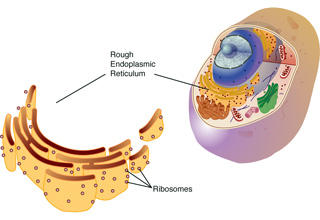
In addition to ensuring that proteins are correctly folded, modified and transported to their final destinations, the endoplasmic reticulum (above) also plays a key role in the quality control machinery of the cell, by recognizing misfolded proteins that need to be degraded. (Courtesy: National Human Genome Research Institute)
Instructor(s)
Dr. Sumana Sanyal
MIT Course Number
7.346
As Taught In
Fall 2011
Level
Undergraduate
Course Description
Course Description
The endoplasmic reticulum (ER) orchestrates different cellular processes by which proteins are synthesized, correctly folded, modified and ultimately transported to their final destinations. As part of this crucial biosynthetic process, proteins that are not properly folded and consequently detrimental to normal cellular function are constantly generated. A common signature of many neurodegenerative diseases, including Alzheimer's and Parkinson's, is accumulation and deposition of misfolded proteins that arise when the ability of cells to deal with the burden of misfolded proteins is compromised. In this course, we will explore how the ER quality control machinery ensures that only properly assembled proteins exit the ER while distinguishing between nascent proteins en route to their biologically active folded state from those that are terminally misfolded.


